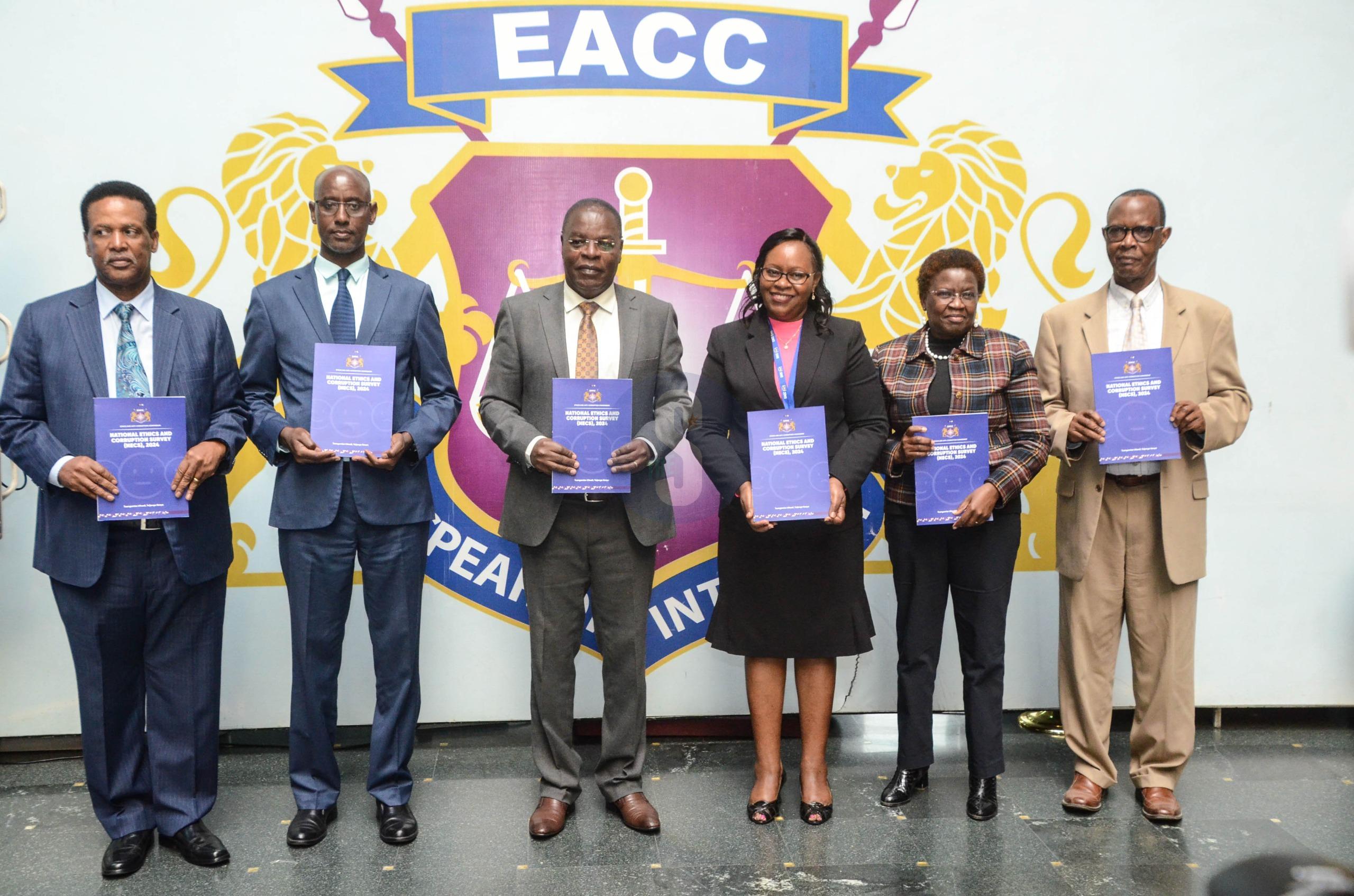

Giving of bribes is the most common form of corruption
witnessed in public offices, followed by receiving of bribes, favouritism, and
abuse of office.
The other forms include tribalism and nepotism, and
embezzlement of public funds, a survey by the Ethics and Anti-Corruption
Commission showed.
The survey ranked corruption as the second most pressing
problem in the country, behind unemployment.
Additional problems identified by Kenyans included poverty,
high cost of living, inadequate health care, poor infrastructure and poor
leadership.
There was an increase in respondents who sought government
services from 60.3 per cent in 2023 to 65.2 per cent in 2024.
The survey measured various corruption parameters such as
forms and awareness of corruption.
The national average bribe decreased from Sh11,625 in 2023
to stand at Sh4,878 in 2024.
On average, services where respondents paid the largest
amount of bribes were while seeking employment from the county executive
(Sh243,651), followed by obtaining a tender from the national government
(Sh100,000) and obtaining a TSC placement (Sh72,665).
While on average, institutions where respondents paid the
largest amount of bribes were the Kenya Wildlife Service (Sh200,000), followed
by the National Social Security Fund (NSSF) (Sh47,129) and the National
Treasury (Pensions Department) (Sh40,000), the report says.
On average, counties where respondents paid the largest
amount of bribes were Uasin-Gishu (Sh25,873), followed by Baringo (Sh16,156),
Embu (Sh12,878), Homa Bay (Sh12,381), Bomet (Sh11,650), Kakamega (Sh10,013),
Tana-River (Sh9,582), Kiambu (Sh7,982), Nyamira (Sh7,748) and Wajir (Sh7,275).
Most of the respondents (43.3%) paid a bribe because it was
demanded, followed by 23.3 percent who indicated it was the only way to access
a service and 18 percent who paid to avoid delay in service and majority
(97.2%) of the respondents who experienced bribery incidences did not complain
or report to any authority or person while only 2.8 percent reporting, the
report says.
A significant majority of the respondents were aware of what
constitutes unethical practice and corruption in public service.
The survey also measured the likelihood, prevalence, impact,
average bribe and share of national bribe across various Ministries, Agencies, Departments,
Counties and services.
The report titled National Ethics and Corruption Survey 2024
Report said the service, government department and county with the highest
average bribe were seeking employment at the county executive, Kenya Wildlife
Service and Uasin-Gishu County, respectively.
The service, government department and county with the
highest likelihood of corruption were obtaining placement from the Teachers
Service Commission (TSC), the Ministry of Labour and Social Protection and
Kwale county respectively, the report said.
EACC Secretary Abdi Mohamud said the prevalence of
bribery measures the rate at which bribes are paid.
Seeking employment, said Mohamud, which has high scores
across all bribery parameters, is linked to the most pressing problem
indentified in the country, unemployment.
“Indeed, we have heard of anecdotal reports that Kenyans pay
very high amounts of bribes to secure positions in the public service.”
He urged all accounting officers to take this report
positively and work towards instituting measures to prevent corruption before
it occurs.
The service, government department and county with the
highest prevalence of corruption were applying for college admission, the Assistant
County Commissioners’ office and Elgeyo-Marakwet County, respectively.
The service, government department and county with the
highest share of bribes were seeking employment at the county executive, Kenya Wildlife
Service and Uasin-Gishu County, respectively, he said.
“Impact of bribery measures the extent to which paying a
bribe influences the availability of services. The service, government
department and county where bribery had the most impact were: seeking payment
from the county executive, Nanyuki Water and Sewerage Company and Kakamega
County, respectively,” he said citing the report.
The commission said that although social media was the third
most utilised media, it was the second utilised in accessing anti-corruption
information, underlining its growing importance.
Facebook was the most preferred social media platform for
accessing anti-corruption information.
EACC wants to work with the public to raise awareness and
knowledge on social monitoring of government projects and services, especially
the most essential services such as health, security and infrastructure
projects.
“The Government should foster an environment that encourages
private sector growth and job creation to alleviate the urge to demand bribes
while providing employment,” said Mohamud.
“Public institutions should develop robust policies that
promote ethical decision-making and ensure accountability. Lastly, the
government should create an environment that allows and encourages employees
and citizens to speak up against any malpractices without fear, threats or
intimidation.”
The Commission conducts National Ethics and Corruption
Surveys pursuant to the provisions of Article 254 (1) of the Constitution,
Section 27 of the Ethics and Anti-Corruption Commission Act, and Section 45(1)
of the Leadership and Integrity Act.
These laws require the Commission to report on the impact of
its initiatives in the fight against unethical conduct and corruption.
The survey provides stakeholders with invaluable data on
corruption levels that assist in assessing the impact of efforts in fighting
corruption and shape the strategies adopted.
The 2024 survey was conducted from 6th November 6, to
December 1, 2024.
It covered a representative sample of 5,960 households
spread across all the 47 counties.
The overall aim of the Survey was to establish the status of
unethical practices and corruption in the country by generating data on the
magnitude of unethical conduct and corruption, perceptions and actual
experiences of unethical practices and corruption, awareness levels, access to
anti-corruption services and effectiveness of existing anti-corruption
initiatives.














